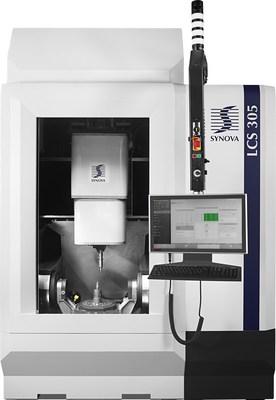
Synova is launching a new CNC machine with full 5-axis capability to process complex 3D geometries. Applications targeted include the machining of industrial diamond employed in toolmaking, as well as various composite materials used in aviation. The LCS 305 offers enhanced accuracy, quality and speed with highly dynamic axes, water-cooled linear and torque motors, mineral casting machine bed and fully automatic offset calibration system.
The flexible Laser MicroJet (LMJ) system enables 3-D cutting and shaping of large and multitooth diamond tools resulting in smooth cutting surfaces and sharp edges for ultrahard materials such as PCD, SCD, natural diamond or tungsten carbide. The machine's two highly dynamic torque motor driven rotary axes also allow chamfering for K-land edges and single or multiple clearance angles. Tools can be exchanged quickly and with a high degree of accuracy thanks to the HSK 63 toolholder.
The LCS 305 laser system with waterjet-guided laser technology is capable of precision machining parts made of ceramic-matrix composites (CMC, a composite made of SiC) while protecting the material from heat-related effects. The low weight and heat-resistant new material is used for hot section aero-engine components to increase aircraft efficiency.
"The issue of heat affected zones and micro-cracks is greatly alleviated when using Synova's unique Laser MicroJet systems because of the inherent heat dissipation properties of the water jet," says Dr. Bernold Richerzhagen, Synova founder and CEO. "The LMJ has already been successfully deployed for the drilling of holes and cutting of CMC shrouds and has proven the necessary precision and reliability required for such applications."
The LMJ 'wet laser' technology cools workpieces while efficiently washing away debris. The waterjet maintains the laser's focus creating a cylindrical laser beam that results in parallel walls and tight kerf widths.
The LCS 305 is a complete CNC system that includes the SynovaCut 5.0 CAD/CAM software and SmartFactory functions, such as an integrated laser power meter, positioning sensor and automatic jet angle correction. It can be flexibly incorporated into production as either a standalone system or into automated lines for operator-free high-volume production.
Contact Details
Related Glossary Terms
- 3-D
3-D
Way of displaying real-world objects in a natural way by showing depth, height and width. This system uses the X, Y and Z axes.
- calibration
calibration
Checking measuring instruments and devices against a master set to ensure that, over time, they have remained dimensionally stable and nominally accurate.
- chamfering
chamfering
Machining a bevel on a workpiece or tool; improves a tool’s entrance into the cut.
- clearance
clearance
Space provided behind a tool’s land or relief to prevent rubbing and subsequent premature deterioration of the tool. See land; relief.
- composites
composites
Materials composed of different elements, with one element normally embedded in another, held together by a compatible binder.
- computer numerical control ( CNC)
computer numerical control ( CNC)
Microprocessor-based controller dedicated to a machine tool that permits the creation or modification of parts. Programmed numerical control activates the machine’s servos and spindle drives and controls the various machining operations. See DNC, direct numerical control; NC, numerical control.
- kerf
kerf
Width of cut left after a blade or tool makes a pass.
- parallel
parallel
Strip or block of precision-ground stock used to elevate a workpiece, while keeping it parallel to the worktable, to prevent cutter/table contact.
- polycrystalline diamond ( PCD)
polycrystalline diamond ( PCD)
Cutting tool material consisting of natural or synthetic diamond crystals bonded together under high pressure at elevated temperatures. PCD is available as a tip brazed to a carbide insert carrier. Used for machining nonferrous alloys and nonmetallic materials at high cutting speeds.
- precision machining ( precision measurement)
precision machining ( precision measurement)
Machining and measuring to exacting standards. Four basic considerations are: dimensions, or geometrical characteristics such as lengths, angles and diameters of which the sizes are numerically specified; limits, or the maximum and minimum sizes permissible for a specified dimension; tolerances, or the total permissible variations in size; and allowances, or the prescribed differences in dimensions between mating parts.
- shaping
shaping
Using a shaper primarily to produce flat surfaces in horizontal, vertical or angular planes. It can also include the machining of curved surfaces, helixes, serrations and special work involving odd and irregular shapes. Often used for prototype or short-run manufacturing to eliminate the need for expensive special tooling or processes.
- toolholder
toolholder
Secures a cutting tool during a machining operation. Basic types include block, cartridge, chuck, collet, fixed, modular, quick-change and rotating.
- tungsten carbide ( WC)
tungsten carbide ( WC)
Intermetallic compound consisting of equal parts, by atomic weight, of tungsten and carbon. Sometimes tungsten carbide is used in reference to the cemented tungsten carbide material with cobalt added and/or with titanium carbide or tantalum carbide added. Thus, the tungsten carbide may be used to refer to pure tungsten carbide as well as co-bonded tungsten carbide, which may or may not contain added titanium carbide and/or tantalum carbide.






